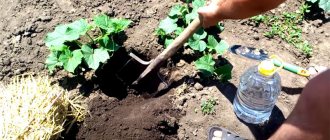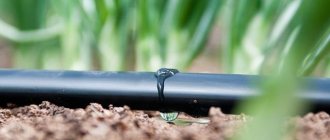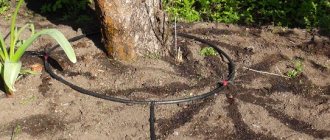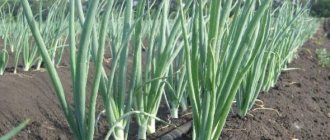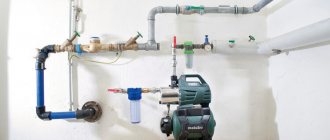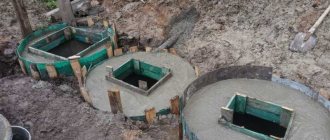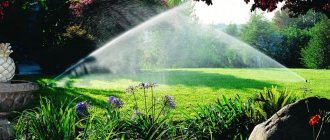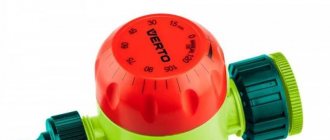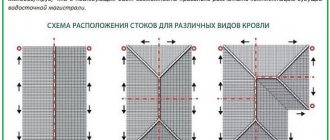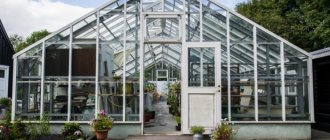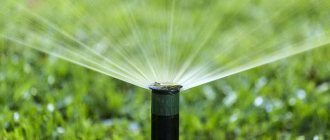Drip watering of plants: features, types
In greenhouses, drip irrigation will be no less in demand than in an open area. After all, regardless of the place where various crops are grown, both energy and time are spent on watering. But installing pipes and containers will not be enough. It is important to have a good understanding of the operation of a particular device that supplies liquid to the plant. All installations are the same only in water supply, that is, in drip irrigation, but in everything else they are different.
Drip irrigation systems are made in such a way that water passes through main pipelines and is supplied to plants through tape parts and droppers. With their help, you can regularly water your plants using small drops, maintaining moisture in the soil.
Drip irrigation in a greenhouse from a central water supply system: installation example
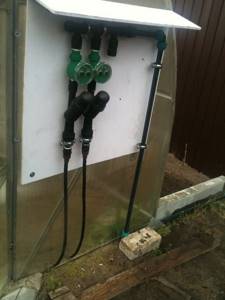
Collector: 2 automatic greenhouse watering zones, 1 emergency exit. Each line has a filter, timer and pressure reducer.
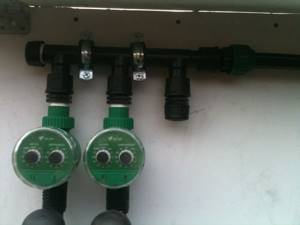
We used an Irritec manifold for 3 outlets 1″ (435)
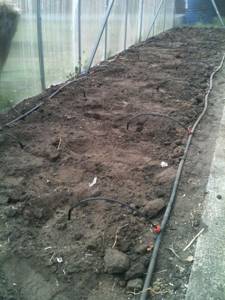
Layout of a “blind” hose and droppers with pegs along rows of plantings
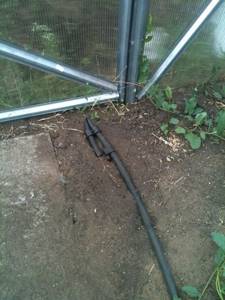
We plug the free ends of the tubes
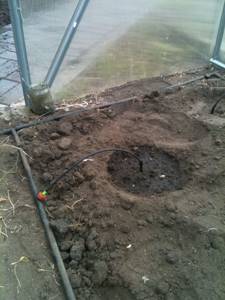
Turn on the water and everything works
I wish you success and great harvests.
What are the pros and cons of a drip irrigation system?
Using such equipment, the soil will always be moderately moistened, comfortable conditions for weed crops will not be created, and water consumption is reduced by a third, compared to classical watering.
Despite the enormous advantages, there are also disadvantages, namely technical and cost-related. The fact is that such systems are complex enough to understand their technical side and install it yourself. You have to call in specialists, and this significantly increases the cost of an already expensive device.
You will also need to regularly check the water that flows through the pipes. It must be clean. Since clogging of watering belts leads to their complete replacement, which will require additional money and time. If such a situation occurs during a particularly hot season, then you may lose your harvest.
Engineers working on the creation of such technology saw possible problems. Therefore, many of them began to look for an opportunity to solve this problem. The clue was nearby, they found it in the rain. Thus, the water supply from the source began to move to the sprinklers. They can be installed both in the garden and next to the roof, it all depends on the concept.
In this option, just like in the first, it will not be supplied through streams, but through neat drops. Using absolutely any sprinkler, you can saturate plants with water on a large plot of land. But this is probably all the advantages.
The disadvantages include the possible threat to which plants grown in a greenhouse are exposed. The fact is that due to such a system, a lot of liquid can accumulate, which will cause burns on the leaves. But even here the experts did not remain indifferent.
When technologists discovered these disadvantages, nature again came to their aid. They were able to solve the problem by directing the liquid to the base of the plants. This has proven to be a very effective method, as it avoids other steps that typically lead to unnecessary water use. But when using such systems, it is necessary to lay pipes underground. Despite the additional aeration, and not just moistening, this affects the complexity of the work performed and the calculation.
For this reason, gardeners use a trick and replace the pipes with ordinary plastic bottles, making small windows in them and burying them next to the plants. This method significantly reduces material costs; you just need to stock up on the required number of bottles.
However, there is a minus here too. In this case, watering will become semi-automatic and will require monitoring the water level in bottles several times a week. On hot days, you will have to devote much more time to this.
Differences between systems are also made by the type of water sources.
The source of water on the site can be a well, a storage tank, an artesian well, a well in the sand and, of course, a water main.
Whatever source you use, the main thing is to monitor the water temperature. Plants do not tolerate air that is significantly cooler or warmer than the water. If you do not take care of this, then no matter what irrigation system you use, great damage can be caused to the plants.
Before watering, you need to let the water sit, especially if we are talking about wells or boreholes. Watering with water taken from an open reservoir is fraught with infection.
During installation, it is necessary to use reducers that compensate for sudden pressure changes in the water pipe. In addition, installing filters is important; this is the only way to ensure proper operation of the system.
Basic elements of a drip irrigation system
In addition to other advantages, this irrigation system has one important advantage: the possibility of self-assembly even from improvised means, since it does not require specific equipment or expensive materials. Of course, this option will be far from ideal, but it will cope with its function.
How to do drip irrigation correctly? To avoid mistakes, first you need to draw a plan diagram of your site. The location of trees, bushes, as well as the types of crops grown should be indicated there. This will make it much easier to understand how to optimally install drip lines, what components you will need, and how many of them.
So, the basic elements:
- A container raised to a height of at least 1.5 meters;
- Distribution pipe with a tap (to connect the line to the tank, you can use a regular hose);
- Fine filter and equipment for connecting it to the system;
- Main water supply (preferably PVC pipe);
- Drip hoses (regular hoses with holes) and tees for connecting them to the system;
- Emitters (dispensers) will have to be purchased;
- Plugs for mains and drip lines.
As they say, cheap and cheerful. However, such a system is quite workable. But it’s easier to buy a special set for drip irrigation; fortunately, their prices are quite affordable. It differs from the above-described scheme only in the presence of a drip tape (i.e., all manipulations with the manufacture of a drip line are not required) and a full set of accessories (taps, plugs, tees, fittings, start connectors, etc.) Naturally, a self-assembly scheme is in the instructions. If you have questions, you can look on the Internet - there are plenty of videos and articles on the topic “Drip irrigation with your own hands.”
Before starting the system, you need to flush it by removing the plugs. When the water becomes clear, the system can be shut off again and put into operation. The same procedure must be repeated periodically for preventive purposes, and the decisive factor in frequency will be the quality of the water. Flushing is also necessary in case of clogging and before preserving the system for the winter.
Drip irrigation - what are its benefits?
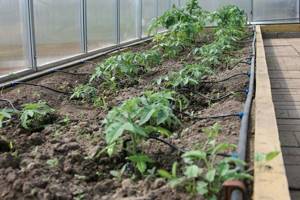
You can talk about drip irrigation of various types for a long time, but the most important thing will be the benefits. What benefits can you get by installing such a device on your site and what impact will it have on vegetable and berry crops?
Using micro-drip irrigation, you can greatly facilitate your work in the garden, reduce financial costs for water, optimizing its consumption. Thanks to such installations, it is possible to significantly reduce the risk of developing various diseases that appear due to excess water in the soil. And also the plants will not need constant attention.
All this is quite obvious, because the ability not to walk around the site with full buckets of water greatly simplifies the work and frees up a lot of time. The fact that the liquid is specifically delivered to specific plants helps not only reduce water consumption, but also increases their fertility.
By using such drip irrigation, crops can be harvested in large quantities in a shorter time. Drip irrigation will deliver water only to specific plants, and not to weeds, which means their growth will be significantly reduced. Among other things, this method does not destroy the soil, unlike the usual one, which, due to uneven distribution, undermines its structure.
Dangerous diseases transmitted to each other are blocked, as the chaotic movement of fluid stops. By combining drip irrigation with liquid mineral fertilizers, the benefits of dosages will increase and useful fertilizers will go directly where they are needed. During particularly hot periods, you can rest assured about your plants, as sunburn will be avoided. It is important that the wind has no effect on the quality of drip irrigation.
What is drip irrigation in a greenhouse and its advantages.
With proper watering, the roots of a crop should receive enough (but not excess) water and a sufficient amount of oxygen. With regular and rain watering, water displaces oxygen from the soil, so mulching is necessary frequently. Drip irrigation in greenhouses does not have these disadvantages.
- Drip irrigation provides sufficient moisture in the soil;
- The technology ensures the movement of oxygen around the roots;
- The soil around the plant does not crust up after drying;
- Water is not used to feed weeds and is used 100% by beneficial crops;
- Fertilizers can be added along with water;
- Possibility of irrigating a large area with low labor costs;
- Drip irrigation systems for greenhouses are easy to assemble or make entirely yourself;
- Easy to operate and maintain the entire structure. Water moves through the pipes very slowly, gradually warming up to greenhouse temperature. The constant humidity regime and optimal temperature recreate a subtropical climate in the greenhouse, beneficial for the growth and fruiting of crops.
Do-it-yourself drip irrigation: device

Drip irrigation devices allow you to avoid strong, impenetrable crusts on the soil that form during conventional irrigation. The water supply occurs evenly, so all the beds will always be moistened and there will be no accumulation of excess liquid anywhere. All work in the garden can be done at a convenient time, and not tied to watering.
The system allows you to avoid damage to plants and dirt on them, since you no longer have to walk through the beds with hoses and buckets. You can loosen and weed the soil less often, and the gap between these two procedures becomes longer. There is a drawback, these are financial costs at the beginning of work and mandatory careful calculations.
There is no doubt that it is quite rational to install drip irrigation systems in greenhouses. By properly building an irrigation complex, you can avoid disappointments and enjoy the benefits.
In their correct configuration, the main ones are the highways that supply moisture to the plants. These can be tapes or tubes. Regardless of the option chosen, they must be laid out in close proximity to the rows. The choice of highways differs in their shelf life. Some choose for one season, others choose those that work for 6 years.
Polyethylene is mainly used in the manufacture of tubes. After correct calculation of the distance, droppers are set. Inside the structures there are small passages resembling zigzags. This was done by technologists in order to reduce water pressure. And this is the right decision, because by creating any other form, it would be impossible to achieve this. And for newly planted seedlings, strong water pressure is very dangerous and can destroy it. You can replace the tubes with tapes; polyethylene is also used for their production. They are twisted in a certain way and their connection occurs using the heat welding method.
During the production of strip structures, small holes are specially made at their seams. They serve as a supplier of water to plants. The tape is laid out so that the drip channels are at the top. For the system to be as practical and reliable as possible, the layout must be located in close proximity to a straight line. If we take into account reviews, experienced gardeners note that regardless of the conditions, with a large area, tapes perform much better in comparison with tubes.
However, in order for watering to be automatic and competent, you cannot use only tubes and tapes. It is impossible to do without installing the main pipeline that supplies the liquid where it is needed.
The essence of drip irrigation
The principle of drip irrigation is to deliver moisture directly to the roots of plants without affecting the stems and leaves. It is known that on a sunny and hot day, drops of water on the leaves form a kind of lens, and the leaves get burned. Drip irrigation in a greenhouse will eliminate these problems.
The greenhouse space is quite limited and the soil is quickly depleted. With regular watering, puddles form on the soil surface, and water does not fully reach the roots of the plants. At the same time, the structure of the soil is also disturbed. When watering is carried out in small doses, the soil structure remains practically intact.
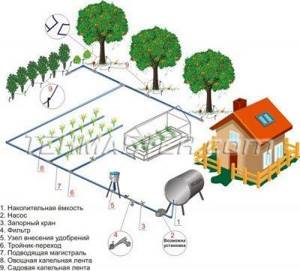
The essence of this method is the cost-effectiveness of supplying water to the greenhouse. Using drip irrigation it is almost impossible to waste water. This is especially true if the site has a central water supply.
Installation of the main pipeline
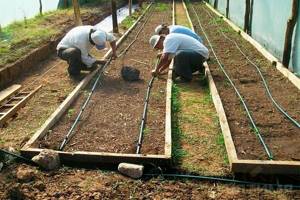
The usual method is to install a tap 1 meter high above the water source. Next, a hose is attached to it, which is pulled to the watering site. There a pipeline is attached to it, which ensures watering of all plants.
In order for the hose to hold well, it must be secured with staples made of wire. This way you can avoid accidental shifts. The pouring channel is a pipe. The length and diameter of which are selected specifically and how this is done will be described below. A filter system that purifies water must be installed on the tank from which the water is taken. The reservoir is necessary; it will protect against the effects of a possible failure in the water supply.
The faucet installation procedure can be carried out before and after the filter element. Regardless of the option selected, the device value will not change. It will regulate the supply time and water flow. Fertigation is a method of fertilization and its unit - often has an important role in the entire system. They are used by gardeners who decide to combine watering with the application of fertilizers and other chemicals. The systems in their modern form have already been tested and tested by time. This allows us to say that plants are guaranteed to absorb all the substances they need.
This has to do with automated systems that deliver moisture to greenhouse plants. But there are a number of cases where there is no need to use such features, since they will be superfluous.
For example, the organic method of growing plants does not involve introducing pesticides and liquid mineral fertilizers into the soil. This means that the corresponding nodes and their configuration are simply not required. In addition, creating a full-fledged irrigation structure is quite difficult, so many are afraid to take on it.
For this reason, there are trade-offs in solving the problem. For example, using plastic bottles or other means. With all the advantages of drip irrigation, we must remember that regardless of the type chosen, they must be carefully controlled. They require constant adjustment and reconfiguration, which is carried out depending on the needs of the plant and weather conditions.
The final elements are selected depending on which plants will be watered, what area will be watered, and, of course, financial capabilities.
They can be compensated or uncompensated. When using the device of the second option, at the beginning of watering more liquid is supplied, and closer to the end of the bed, it is supplied in less quantity. As for the first option, here the water will be distributed evenly, regardless of pressure surges. When the height has significant differences, the method of irrigation using compensated devices allows you to avoid negative impacts. Both devices do not pump out all the water, even if the operation has completely stopped.
This can be considered a plus, since when starting the system again, it does not waste time pushing the air out. Sometimes other systems can be used that can release water to more than just one plant, but they require large financial investments.
A collapsible type dropper is always made and does not depend on what kind of system is installed. When installing droppers, you must maintain a distance of 30 centimeters between them. However, this does not apply to all plants; there are those that require the use of other irrigation schemes. So-called "spiders" are used when growing perennial plants. They are considered the best option in this case. For them, the mains through which water flows must be suspended. To irrigate root crops, the installation should be at a distance of 20 centimeters. For melons and melons, a distance of 100 centimeters is maintained.
Drip irrigation for a greenhouse: features
To get a large harvest of vegetables, herbs or berries, fertilizers alone are not enough; proper watering plays an important role.
Typically, greenhouses are small in size . The land simply becomes depleted and loses its nutrients, and after a few years the harvest is not as rich as it was last year. And if you add water shortage to all this, the result will be even worse.
All these problems can be avoided if you arrange proper watering of the soil with your own hands. This system directly supplies water to the roots of plants and nourishes them, which promotes proper growth and good fertility. Another feature of a drip structure is that if fertilizers need to be applied, they can be diluted in a water container and the nutrient material will flow to the right place.
Benefits of drip irrigation
- Possibility of automated watering.
- Increasing the fertility and productivity of plants.
- Climate resistance.
- Equal water distribution.
- Possibility to turn on watering at a certain time.
- Easy to install and manage.
- Reduced soil leaching.
- Possibility of applying fertilizer directly to the roots.
- You can do it yourself.
By setting up an automated greenhouse watering system, you can save time and effort .
Principle of operation
The peculiarity of the watering design is that each plant receives water individually. Water supply to the roots can occur constantly in small doses or periodically - it all depends on the need. In this case, the soil near the root part of the crop is constantly moist, and thanks to this the plant receives the liquid correctly.
The water in the drip system moves gradually , which makes it possible to heat the liquid to the required temperature, and this is an important factor in the favorable watering of plants. An optimal climate in a greenhouse combined with water at the required temperature will ensure a good harvest.
Water consumption for drip irrigation
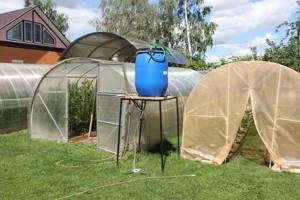
In addition to choosing the design of the system, you also need to understand how much water should pass through the homemade holes. This must be done in order to decide on the choice of source and how they can be used in different conditions.
In addition, there is a nuance that must always be taken into account. Since it can become something that will entail many negative consequences. In an effort to save water as much as possible, you can make the consumption so insignificant that it simply will not be enough to provide the required amount of moisture to the plant. As a rule, this is the reason to talk about improper drip irrigation.
It is necessary to calculate based on an analysis of the internal air temperature, moisture level, type and variety of plant, light intensity. When turning to literature written by specialists, it is difficult not to be scared, because the description is quite scientific. In them, using Pennman's equations, they describe the method, referring to the use of potentiometers and strain gauges.
Reputable organizations that organize large greenhouse farms use equipment that allows them to constantly monitor all fluctuations associated with changes in the stem around the clock. But even professionals currently do not have a method that allows them to inform in advance about the required water consumption. For this reason, it makes no sense to use such equipment on personal plots. This is not only difficult, but also requires a large investment of money.
And yet there is a way out. Reference books on agricultural technology and botany can tell you about the needs of various garden crops. But, unfortunately, this information is not enough. It is also necessary to take into account the soil on which the plants are grown, namely, what is its minimum moisture capacity. Considering that the chemical composition and mechanical structure of the soil are different, the characteristics are very different and only in laboratory conditions can the value be accurately determined.
The next important calculation parameter is drip irrigation, namely its frequency. In order to calculate it, you need to know not only the minimum moisture capacity, but also the maximum values and the level of humidity that affects wilting. The minimum moisture capacity can be determined by the condition of the soil. The water saturation of the capillaries at the moment will be 100% and at the same time there will be the presence of air in the pores. With such a balance, the best conditions will be created, which we should strive for. Maximum moisture capacity is the abundant moistening of pores and capillaries.
There is also nothing complicated about wilting moisture, although the term seems very scientific. He talks about the high dryness of the soil and the pressure difference at which the osmotic supply of water cannot be ensured. Which entails a loss of plant tone and its death. If such a situation occurs, then it will no longer be possible to correct it with the help of intensive watering and further moistening. If the soil is dense clay or heavy sand, then its maximum moisture capacity will be almost equal to the wilting moisture content.
For this reason, watering every two days can make the soil too wet. But sometimes, after one day, the soil will again become dry. For loamy soils, watering once every three days will be sufficient. The values are changeable and the calculation of moisture requirements is made based on how much water is needed for a particular plant variety. It also depends on the planting density, the number of rows and the duration of watering carried out daily.
Automatic and manual start of drip irrigation system
Everything is simple here - if the system is not automated, you will have to constantly monitor the filling of the container, and also shut off the system when it rains. The only gain in this situation is cost savings when purchasing equipment. In principle, such a system can be dispensed with if the greenhouse is located on a site near your own home. Otherwise, you will need a pump and a special controller that will ensure complete autonomy of the system (watering in accordance with a given program, as well as automatic pausing in case of precipitation). Controllers are battery-powered or plug-in minicomputers that allow you to set a specific watering program. Single-channel ones are cheaper and easier to manage, but they can only automate one area. Multi-channel controllers are more difficult to control, but they can control eight zones simultaneously. Let us remind you that the model and power of the pump depend on the volume of the container, so when purchasing, consulting a specialist will not be superfluous.
Watering is turned on and off as needed, usually several times a day. When the system operates correctly, one and a half to two hours after startup, a wet spot with a diameter of 10-15 centimeters appears around the dropper. If its diameter is smaller or, on the contrary, a puddle appears, this is a signal of a system malfunction.
Automated systems: what are their advantages and disadvantages

Once the exact fluid requirement has been determined, we need to decide how we want this flow to be managed. Automatically or manually.
Automatic drip irrigation certainly has many advantages. This makes care much easier, does not require physical strength, and gives you more free time. And by installing systems with timers, you can stop worrying about your garden crops drying out.
However, despite the apparent simplicity, everything is not entirely true. In order to install a high-quality automatic system that can make gardening easier, you need to invest a lot of money. Installation and adjustment will also require the work of a professional. Maintenance is required twice a year. In addition, water sources must meet the required capacities and characteristics. So that in the event of damage to the system, a swamp does not appear in the greenhouse. It is important to design carefully and take into account all the smallest nuances.
Water supply options
After the choice between automatic and manual systems has been made, it is necessary to decide how the liquid will be supplied. With only rare exceptions, food comes directly from a well or water supply. Usually this is a tank or barrel.
When drawing up a pipeline network plan, you need to focus on the location of the greenhouse, soil, topography on the site and compliance with generally accepted standards for organizing proper irrigation.
Getting water from underground sources is difficult and expensive. If you connect to a water supply that has already been installed, this will simplify the task and make it cheaper. The big advantage of this is the purity of the water. But this does not mean that chemical analysis is not needed, since unpleasant surprises can be expected even from wells drilled into sand.
When choosing a system, you also need to understand whether it needs natural pressure or should be equipped with pumps. In both cases, the design will be designed to water a large area of land. With low pressure, watering is possible on 10 meters of the bed. When installing a system with a more intense flow, it will be necessary to invite specialists, since its installation is more complex.
Automation options for drip irrigation
There are several types of drip irrigation, but any do-it-yourself drip irrigation system for greenhouses must satisfy the following condition : water must be supplied not between the rows, but to the roots of the plants. If this is not done, the following consequences are possible:
- crops will develop worse, and weeds will grow;
- the need for loosening will increase;
- The soil will heat up under the sun's rays.
A do-it-yourself automatic watering system in a greenhouse can be made either from improvised means or using professional equipment.
System from improvised means
How to make drip irrigation in a greenhouse yourself? Let's find out. If you have a small area, then do shallow drip irrigation. To do this, you will need to buy a PVC garden hose; choose one with a clearance diameter of 3 to 8 mm.
You need to make dies in it. Buckets can be used as a tank by making holes in their bottoms. Close the spout with a standard plug. Sometimes you have to use thin rubber seals. This is the best solution if you come to the country only for the weekend. The system unfolds and collapses. Before you leave, you quickly put it back in place. Automatic watering for a greenhouse with your own hands - diagram - look at the photo on the left.
With water supply through a pipeline
This method of irrigation is perfect for large areas of land. It all depends on the pressure . You can choose to build according to a full or simplified scheme. Low pressure - 0.1-0.3 bar, normal - pressure 0.7-3 bar. For a pressure of 1 bar, it is necessary to raise the tank by 10 m, but for low-pressure installations it is enough to raise the tank by 1-3 m. It is technically impossible to water twenty-meter beds.
Attention! Remember that in a low-pressure system you can create high-quality irrigation only for beds whose length does not exceed 10 m.
Of course, today there are high-pressure irrigation systems. Mist irrigation provides great benefits, but it is impossible to do such an installation yourself. You will need to contact specialists. In addition, it must be taken into account that the cost of such installations is high.
How to make drip irrigation in a greenhouse at home
After you have managed to figure out the water consumption and the design of the irrigation system, you need to figure out the organization of spraying in the space. If there is a natural supply of water, then it will be enough to install one main line and branches. But the functionality of simple systems is not popular among gardeners. To create the correct scheme, you need to determine how the plants will be located in space.
Drip irrigation in a greenhouse: diagram
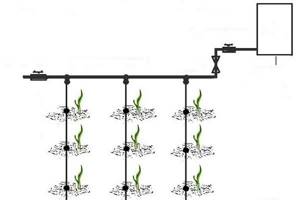
The diagram should reflect how the main pipes will be placed, where there will be places where shut-off fittings will be installed and where drip tubes and separate droppers will be located.
Pipe equipment or hoses can be laid out on the ground or using special supports underground. In the first case, everything is quite easy and simple. The main thing is to use only pipelines that do not allow sunlight to pass through, as they pose a threat to the development of pathogenic bacteria.
If the second option is chosen, then you will need to use a material whose walls will be strong and thick.
If the area is flat, then the hoses should run at an angle. Before installing them, you need to make markings indicating the location of each connection. This way you can correctly calculate the required number of components. This point is very important, so you should not ignore it.
Set of required tools and components
To independently organize drip irrigation in a greenhouse, you will need to use main plastic pipes. They are quite light, inexpensive and can be used for watering perennial plants. If there is no water supply or it has low power, an excellent option would be to install a tank at a height of two meters. It is very important that air and sunlight penetrate into the selected structures, if at all, then in small quantities, otherwise algae will begin to develop.
The generally accepted technology involves the inclusion of filters and starting connectors in the set. Each set may differ in the number of connectors and their types. To properly equip the system, you will need a pump with the appropriate parameters. At the moment, there is no special pumping device, so you need to choose those that can pump the required volume of cold liquid. When selecting equipment, it is necessary to take into account the height of water pumping and its intensity of passage. This is the main thing when choosing.
It is possible to use pumps designed for heating systems. But only if 100 liters of water per hour is sufficient for watering. Drip tapes in most cases are designed taking into account a pressure of no more than 1 atmosphere. If the products have thickened walls, then the pressure can be twice as high. A pressure of no more than 4 atmospheres can be supplied to external droppers. However, it should be remembered that the length of the water route can be long. And this is the presence of changes in trajectories and intersections. All this can reduce the pressure during the movement of water to the plant, and this should not be underestimated. For this reason, gardeners prefer to purchase more powerful pumps.
We act in order
It should be noted that systems require mandatory flushing, regardless of whether the components used are old or new. To do this, you need to remove the plugs and let air through. This is done until the moving stream is completely cleansed.
First of all, the main pipes are installed, which are stretched along the paths. On the right and left sides of the highways it is necessary to organize wiring. To connect such dissimilar segments, you will need joining devices that can be disassembled.
Tapes and tubes should not be connected at distribution points until this stage of work is completed. When the pipe is cut off in the required area, a plug is installed on one side of it, and on the other, a transition is made to the water supply line using a tap. The holes on which the connectors are attached should be 1.4 centimeters. It would be correct that the distance between them corresponds to the distance between the plants. The sealing gasket is installed on the dispensing taps. And when installing the starting connector, use soap dissolved in water or silicone grease.
Most gardeners like to use polyethylene pipes to connect the water supply to the spill line. A collapsible type connection can be installed between the tap and the last section of the pipeline. This may only be relevant if the greenhouse is seasonal. To do this, you need to roll out the tape and tie the sleeves to the water supply taps. Here the preparatory activities for work end.
Do-it-yourself automatic drip irrigation for a greenhouse from a barrel
Hello, dear reader! In this article I want to tell and show how easy it is to make automatic drip irrigation for a greenhouse from a barrel with your own hands. For example, I took a 3x6m greenhouse with the arrangement of beds as in the photo below
So, in order to do competently automatic drip irrigation in a greenhouse, I recommend proceeding in the following sequence:
- Draw a plan for the location of the beds with dimensions. (I draw in SketchUp) The beds are drawn from 50*150mm timber, in two rows, bed height 300mm
- Decide what you will grow in the greenhouse. (for example, grow peppers and the remaining two tomatoes).
- Calculate the approximate water consumption per day for the greenhouse
- To select a barrel of the required volume, in this article we consider a situation where it is necessary to water it during the week. And on the weekend we fill it again by hand. Automatic filling is not provided. However, you can solve it with the help of a float valve (from the toilet barrel), I read on the Internet that this is not the best way, sometimes it holds very poorly and the container overflows, so I will not write about it in this article. I want to make filling with an electromagnetic valve. But that’s in the next article. It is necessary to select the necessary components.
- Calculate the number of required 16mm blind tube and 3x5mm microtube to connect the system together.
- Calculate the required number of different fittings. In the photo below you can see where which fittings are used. At the end of the article, I will write a list of materials and fittings required to organize the same watering in my greenhouse or in my beds. Decide on the quantity yourself.
- Choose a timer faucet with a ball mechanism, since the system operates by gravity.
- Install the system.
The goal of selecting components was to do it once and for a long time, so I chose adjustable drippers for the greenhouse on a peg, so that if necessary, it was possible to shut off the water supply to a certain plant. Of course, it was possible to use a drip tape or regular dropper pegs, but this article deals with the question of practicality, convenience and a longer service life of the system. I also installed a tap in each bed.
The irrigation diagram shows that I have 12 drippers on the outer beds, 21 drippers on the middle bed, for a total of 45 adjustable drippers.
We select the barrel based on the water consumption per day; theoretically, 45 l/h should be consumed for the entire greenhouse. provided that I set the flow rate of the droppers to the minimum. Bill of materials for organizing automatic drip irrigation in a greenhouse 3x6m
| No. | Name | Article (link to product on our website) | Required quantity for our greenhouse | Photo | A comment |
| 1 | Water tank (min 200 l) | — | 1 PC | Can be bought on Avito or Yula or in the store | |
| 2 | Insertion into a tank (barrel) for irrigation 3/4 | VR3/4 | 1 PC | Available on the website | |
| 3 | L-shaped coupling, 3/4″out x 3/4″in | MF063434A | 1 PC | Available on the website | |
| 4 | Faucet 3/4″out x 3/4″in | MF013434 | 1 PC | Available on the website | |
| 5 | Filter, 3/4" out x 3/4 in, mesh | 1725S120FM | 1 PC | Available on the website | |
| 6 | Electronic watering timer | GA-322N | 1 PC | Timer required with ball mechanism, available on the website | |
| 7 | Coupling for tube 16mm x 3/4″inside | FC011634 | 1 PC | Available on the website | |
| 8 | Angled connector 16mm (EC0116) | EC0116 | 11 pcs | Available on the website | |
| 9 | Tee 16mm x 16mm x 16mm (TC0116) | TC0116 | 2 pcs | Available on the website | |
| 10 | Tube plug 16mm (EL0216) | EL0216 | 3 pcs | Available on the website | |
| 11 | Tap for tube 16mm (MV0116) | MV0116 | 3 pcs | Available on the website | |
| 12 | 16mm tube clamp (HY4613) | HY4613 | 38 pcs | Available on the website | |
| 13 | HDPE pipe D=16mm L=25 m, for all types of drip systems | 2455 | 1 bay (25 m) | Available on the website bays from 25m to 400m | |
| 14 | PVC soft tube 4x7mm, 4.0bar (per cut) | 800 | 21 m | Can be purchased in pieces starting from 1 running meter. | |
| 15 | Adjustable dropper, 1/4″, 0-70 l/h - 1 bar on a 15cm stand (AOD0170H) | AOD0170H | 45 pcs | Available on the website. Collapsible, starter adapter included | |
| 16 | Hole puncher for droppers | 1 PC | Available on the website |
I hope this article helps someone.
You can buy all components for irrigation on our website (except for the water tank). If you need exactly this version of the system for your greenhouse, then I will give a 7% discount on this set. Just call or write to us and tell us that you need a set like the one in the article. If you have any questions, call or write, we will answer everyone, we will not leave anyone unattended! Thank you for your attention and have a good harvest!
